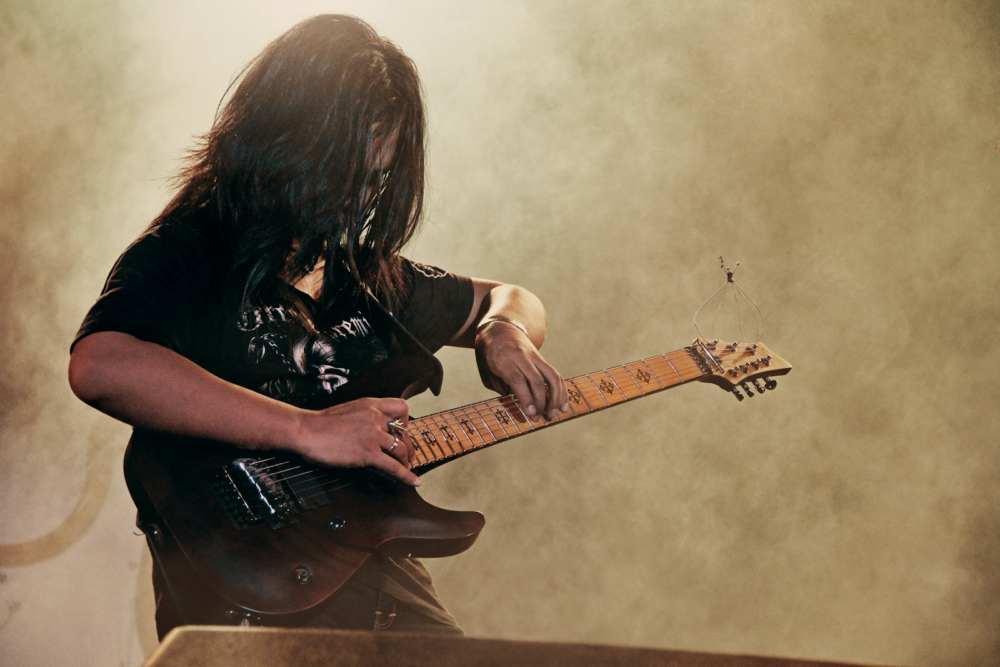Dimebag Darrell, a name that resonates with a thunderous echo through the halls of rock and metal music, remains a figure of almost mythic proportions. His approach to the electric guitar defined an era and carved out a legacy that continues to inspire awe and admiration.
Darrell’s prowess wasn’t just in his fingers or his phrasing; it extended into the very tools of his trade—his guitars. This article delves into the distinctive array of guitars that Dimebag wielded like a warrior poet, creating riffs that were at once anthemic and a masterclass in metal virtuosity.
From the storied depths of the Dean from Hell to the innovative lines of the Dean Razorback, each guitar tells a story. A story of shows played, solos improvised, and the relentless pursuit of tone. Dimebag Darrell’s guitars became extensions of the man himself, each one an integral character in the saga of one of the most influential guitarists in the history of heavy metal.
Let’s strap in and turn it up as we explore the instruments that helped Dimebag Darrell leave an indelible mark on the world of music, one power chord and divebomb at a time.
The Legend of Dimebag Darrell: A Riff Master’s Journey
Dimebag Darrell, born Darrell Lance Abbott on August 20, 1966, was not just a musician; he was a force of nature in the world of heavy metal. His journey began in Arlington, Texas, where he was born into a musical family that fueled his fiery passion for music. By the tender age of 12, Darrell was already showcasing prodigious talent, having won a series of guitar competitions that resulted in his being banned due to his unmatched skills.
Early Years and Pantera
In 1981, at just 15 years old, Darrell, alongside his brother Vinnie Paul on drums, formed Pantera. The band, initially influenced by glam metal, underwent a transformation in the late 80s. They morphed their style into a heavier sound, a change that was accompanied by Darrell’s own transition from the stage name Diamond Darrell to Dimebag Darrell—a moniker that would become synonymous with metal guitar mastery.
Rise to Fame
The release of ‘Cowboys from Hell’ in 1990 marked Pantera’s arrival on the major metal scene. Dimebag Darrell’s riffs were an integral part of the band’s signature sound—a blend of relentless power and technical precision. His ability to blend complex rhythms with searing lead work on tracks like “Cemetery Gates” set him apart from his contemporaries.
The Iconic Years
Throughout the 90s, Dimebag solidified his status as a guitar icon. With albums like ‘Vulgar Display of Power’ and ‘Far Beyond Driven’, which debuted at number 1 on the Billboard 200, Dimebag became the heart of Pantera’s sound. His use of the Floyd Rose tremolo, his signature squeals, and his bone-crushing power made the DR strings on his guitars wail in a way few could replicate.
Beyond Pantera
After Pantera disbanded in 2003, Dimebag and his brother formed Damageplan. They released ‘New Found Power’ in 2004, and while it was a departure from Pantera, it still carried the unmistakable imprint of Dimebag’s guitar work.
His Untimely Demise
The music world was left reeling when, on December 8, 2004, Dimebag Darrell’s life was tragically cut short during a performance with Damageplan. His death was not just a loss for those who knew him but for the entire guitar world.
Dimebag’s Legacy
Dimebag Darrell is revered as an icon for several reasons. His fearless innovation with Dean guitars, like adding a lightning bolt design to the ‘Dean from Hell’, showcased his creative spirit. His tone, characterized by the use of a solid-state Randall amplifier and a Digitech Whammy pedal, was uniquely his. The image of him power sliding across the stage while ripping through solos is etched into the annals of metal lore.
Moreover, Dimebag had a way of connecting with fans that went beyond his music. His larger-than-life personality, his love for fun and laughter, and his unending generosity made him a beloved figure in the metal community. It was his remarkable humility, despite his towering presence in the industry, that endeared him to legions of fans and fellow musicians.
Dimebag Darrell’s impact extends beyond the notes he played. He pushed the boundaries of what a guitar could do in metal. He wasn’t just playing barre chords; he was creating a soundscape, a canvas where every divebomb and harmonic squeal painted a picture of raw, unbridled emotion and power. His influence can be seen today in the legions of guitarists who cite him as an inspiration and in the ongoing sales of his signature guitars, which continue to introduce his sound to new generations.
In the annals of guitar heroes, Dimebag Darrell stands as a titan, his legacy immortalized in every riff that echoes from a Dean or Washburn guitar and in the heart of every metalhead who has ever been moved by his music.
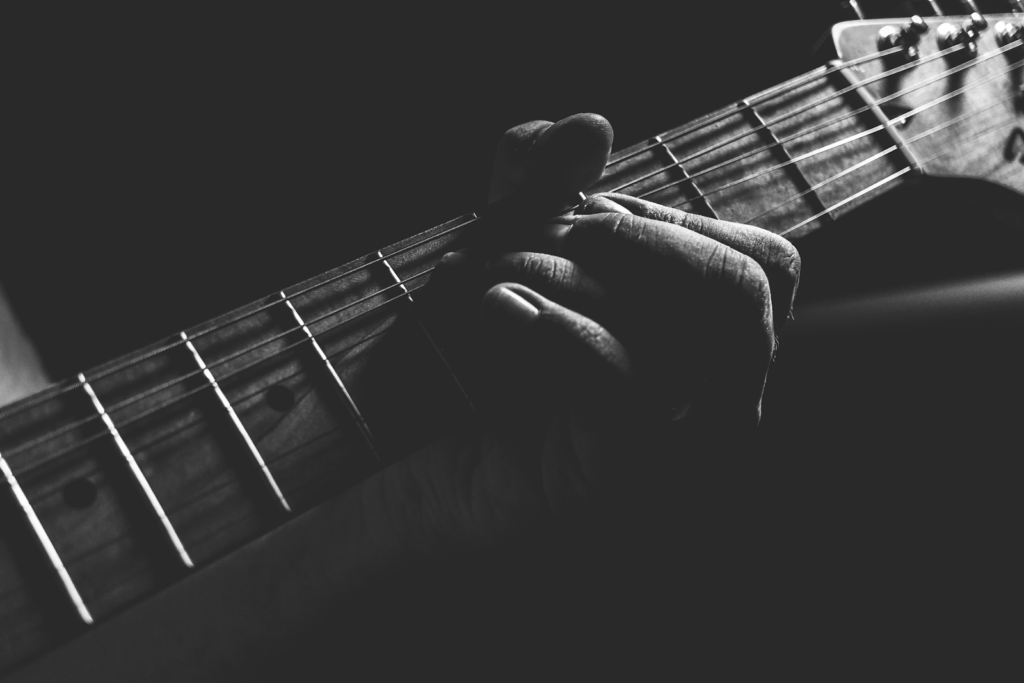
The Dean ML – “Dean from Hell”
In the pantheon of Dimebag Darrell guitars, the Dean ML, known as the “Dean from Hell,” is akin to a relic of metal. This iconic electric guitar was Dimebag Darrell’s partner in crime from 1980 to 1994, during the very years that carved his name into the annals of guitar world history. “Dean from Hell” wasn’t just an instrument; it was an extension of Dimebag’s own musical soul.
Interestingly, Dimebag Darrell’s relationship with Dean Guitars began with a twist of fate. The day he first laid hands on the “Dean from Hell,” he ended up leaving with two Dean MLs, but not before deciding to sell the one he had initially won. Yet, as if by destiny, the guitar he parted with found its way back to him and became the celebrated centerpiece featured on the cover of ‘Cowboys from Hell’.
The guitar’s scorching tones and razor-sharp capability to play barre chords with ease made it a legend within the metal community.
The 1979 Dean ML – “Far Beyond Driven”
When metalheads discuss the arsenal of Dimebag Darrell’s guitars, the 1979 Dean ML rightfully earns its place in the spotlight. Crowned as the “Far Beyond Driven” guitar, this mahogany body masterpiece became Dimebag’s signature guitar from 1994 to 1995.
As the name suggests, this Dean guitar became synonymous with the ‘Far Beyond Driven’ album, echoing the gritty and aggressive sound that Dimebag was known for. Originally adorned with a tobacco sunburst, the guitar featured a Floyd Rose tremolo and an Original DiMarzio bridge pickup, a configuration that later inspired Dean Guitars to re-issue a limited run.
This reissue was a collector’s gem, showcasing a burst-flamed maple top paired with the traditional mahogany body and updated with the signature Seymour Duncan Dimebucker pickup, aligning with the preferences of the guitar world’s metal enthusiasts.
Washburn Dime 3 Prototype – “Lightning Bolt”
Transitioning from Dean guitars, Dimebag Darrell’s foray with Washburn guitars began in 1995 and lasted until 1998.
The Washburn Dime 3 Prototype, emblazoned with the striking “Lightning Bolt” design, was a testament to Dimebag Darrell’s towering stature in the realm of metal.
The success Dimebag experienced with Pantera was pivotal in Washburn’s decision to partner with him to create a signature guitar that would resonate with the explosive energy of his playing style. The primary model during this partnership was the ‘Dime 333’, reminiscent of the original ‘Dean from Hell.’
This electric guitar was introduced in three color schemes, but it was the “Lightning Bolt” that electrified the guitar world. Dimebag’s contract with Washburn spanned a decade, during which various models were introduced, including a customizable US-made version that allowed the player to choose from a range of features, such as the type of neck pickup or whether it had a rosewood fingerboard.
All Washburn Dime models owed their heritage to the unmistakable headstock shape and design ethos of the Dean ML models.
Washburn Dime 3 – “The Great Southern Trendkillers”
The Washburn Dime 3, aptly nicknamed “The Great Southern Trendkillers,” served as a battle axe for Dimebag Darrell from 1996 to 1999.
This particular model became one of Dimebag Darrell’s main guitars and was a staple around the release of Pantera’s potent 1996 album. It wasn’t just any Washburn ML; this guitar bore the rebel flag design, screaming defiance, with the bold declaration of “Great Southern Trendkillers” adorning its body.
Dimebag’s preference for a Floyd Rose tremolo system was evident, as was the inclusion of a Bill Lawrence L-500XL bridge pickup coupled with a Seymour Duncan SH1-N’59 neck pickup. This configuration, along with Dimebag’s technique, allowed for those biting leads and heavy rhythms that defined Pantera’s sound during this era.
Washburn Dime 3 – “Slime”
The “Slime” version of this guitar, which Dimebag Darrell wielded from 1995 to 1999, boasted a vivid green and yellow sunburst finish that was as unmissable as the guitarist’s presence on stage. This guitar wasn’t just visually striking—it was a symbol of Dimebag’s unique style.
The presence of a green Volkswagen sticker became as much a part of its identity as its sound was to Dimebag’s arsenal. The “Slime” shared the same heart as its sibling “The Great Southern Trendkillers”, featuring a Seymour Duncan SH1-N’59 pickup and a Bill Lawrence L-500XL bridge pickup, crafting tones that could slice through any mix with precision and attitude.
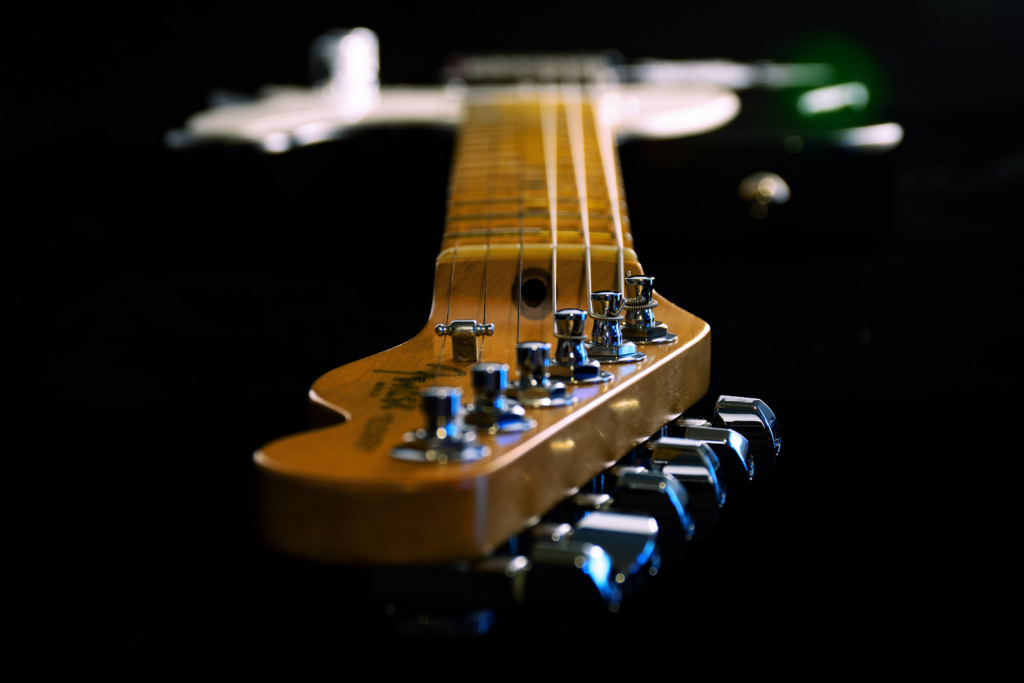
Washburn Dime 3 – “Trendkill”
This guitar made a significant impact during the Ozzfest in 1998. Its cameo finish and the prominent “Trendkill” inscription on the horn made it as visually arresting as the sounds it produced. The word “Roswell” along the side further accentuated its extraterrestrial vibe, complemented by a sticker of an alien skull on the back, possibly nodding to Dimebag’s interest in the otherworldly.
This guitar wasn’t just for show; it packed a punch with the same trusted pickup combination featured in other Dime models, providing the sonic firepower necessary for the metal onslaught Dimebag delivered at one of the largest gatherings of metal fans.
In the realm of Dimebag Darrell guitars, these three models are significant chapters in the story of a guitar legend. They not only reflect Dimebag’s personal style and the flamboyance of metal but also demonstrate his unwavering commitment to tone and playability.
Whether it was the headstock shape or the integration of a rosewood fretboard, Dimebag’s partnership with Washburn guitars yielded instruments that were both visually and sonically in line with the guitarist’s larger-than-life persona. Each of these guitars, just like Dimebag Darrell himself, left an indelible mark on the guitar world.
Washburn Culprit
The Washburn Culprit represents a distinctive chapter in the evolution of Dimebag Darrell’s guitars.
Between the years 1998 and 2000, Dimebag, seeking a departure from the ubiquitous “ML” style, channeled his creative energies into the design of a new guitar. With clear influences from the robust Gibson Explorer, the Culprit featured a body and headstock that were the fruits of Dimebag’s own design aspirations.
This guitar wasn’t merely a shift in aesthetics; it was a statement of Dimebag’s willingness to innovate and tailor instruments to his precise specifications. The Washburn Culprit, while lesser-known, was a bold step into a new visual territory while maintaining the aggressive tonality demanded by metal.
Dean Razorback
In the later phase of his career, from 2003 to 2004, Dimebag Darrell rekindled his relationship with Dean guitars to develop the Dean Razorback. This guitar was birthed from Dimebag’s desire to fuse the core concept of the Dean Stealth model with a fresh signature series that he co-designed with Dean.
Tragically, Dimebag never got the chance to use the model in a live setting, but he played the prototype and gave his approval, ensuring the guitar met his standards. The finalized Razorback model boasted a selection of body woods—mahogany, maple, or basswood—and offered a choice between an ebony or rosewood fingerboard.
The potential for customization extended to its pickups, with options including EMG, DiMarzio, or Seymour Duncan. The Dean Razorback has since been in full production, with a plethora of color and specification variants, each one a tribute to Dimebag’s enduring legacy within the guitar world.
Both the Washburn Culprit and the Dean Razorback underline Dimebag Darrell’s role as not just a guitar icon but also an innovator in guitar design. His fingerprints on these instruments are a testament to his vision for metal music and guitar crafting. These guitars, each with their unique body design, and potential for a rosewood fingerboard, symbolize the innovative spirit of Dimebag Darrell’s contributions to the world of electric guitar and metal.
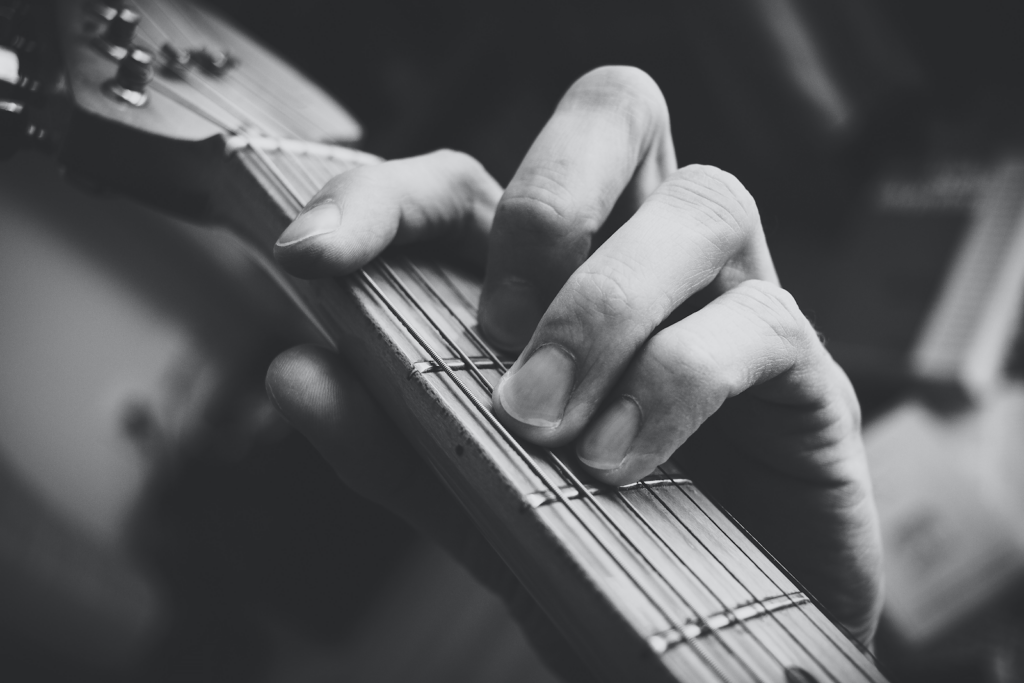
Amplifiers That Defined Dimebag Darrell’s Sound
Randall RG100HT: The Backbone of a Signature Sound
The Randall RG100HT is an amplifier that is inseparable from the legacy of Dimebag Darrell’s sound. Known for its bone-crushing aggression and punch, the RG100HT was the solid-state powerhouse behind Dimebag’s live performances. Unlike the warmth of tube amps, this Randall offered a distinct, edgy tone that perfectly complemented Dimebag’s playing style.
For those seeking to emulate the quintessential Pantera sound, particularly the groundbreaking tone heard on the ‘Cowboys From Hell’ album, the Randall RG100HT is the holy grail. With its full head and 100-watt power amp configuration, it became as iconic as the riffs it helped create.
Although this amplifier has been discontinued, its sonic fingerprint on metal remains indelible. Dimebag’s use of the RG100HT is a testament to his dedication to crafting the perfect metal tone, which didn’t necessarily require the most expensive or complex equipment.
Randall Century: From Writing Riffs to Global Hits
The Randall Century amplifier was another key component in Dimebag’s arsenal. While it was initially a staple in his writing process, the solid-state Century, boasting a 120-watt power amp, quickly became a mainstay for both studio recordings and live shows. Its full, traditional head enclosure packed a punch that delivered the high-octane energy required for Pantera’s blistering tracks.
What made the Century stand out was its ability to convey the intricate nuances of Dimebag’s playing. Whether he was laying down aggressive rhythms or peeling off lightning-fast solos, the Century amp provided the necessary clarity and reliability. Dimebag’s choice to use the Century for both creative writing sessions and during performances speaks volumes about his trust in its consistent delivery of high-quality sound.
Randall Warhead: The Birth of a Signature Amp
The Randall Warhead holds a unique place in the pantheon of amplifiers—it was the world’s first signature amplifier, designed and crafted to meet the exacting standards of Dimebag Darrell himself.
This amp was the culmination of Dimebag’s hands-on input and Randall’s engineering expertise. With two channels that offered independent gain and volume controls, dual 3-band EQ, and a 9-band graphic EQ, the Warhead was nothing short of a sonic juggernaut.
The inclusion of built-in effects, such as delays and reverbs, meant that Dimebag could achieve his expansive sound without a plethora of pedals, streamlining his setup for maximum efficiency and impact.
The Warhead’s 300-watt power amp and its dedicated mid-sweep allowed for precise tonal shaping, which was integral to cutting through the mix during Pantera’s high-decibel live performances.
For fans and aspiring guitarists, these amplifiers are not just pieces of equipment; they are the building blocks of a sound that would define a genre. They embody Dimebag Darrell’s relentless pursuit of the perfect metal tone—a legacy that continues to resonate throughout the world of music.
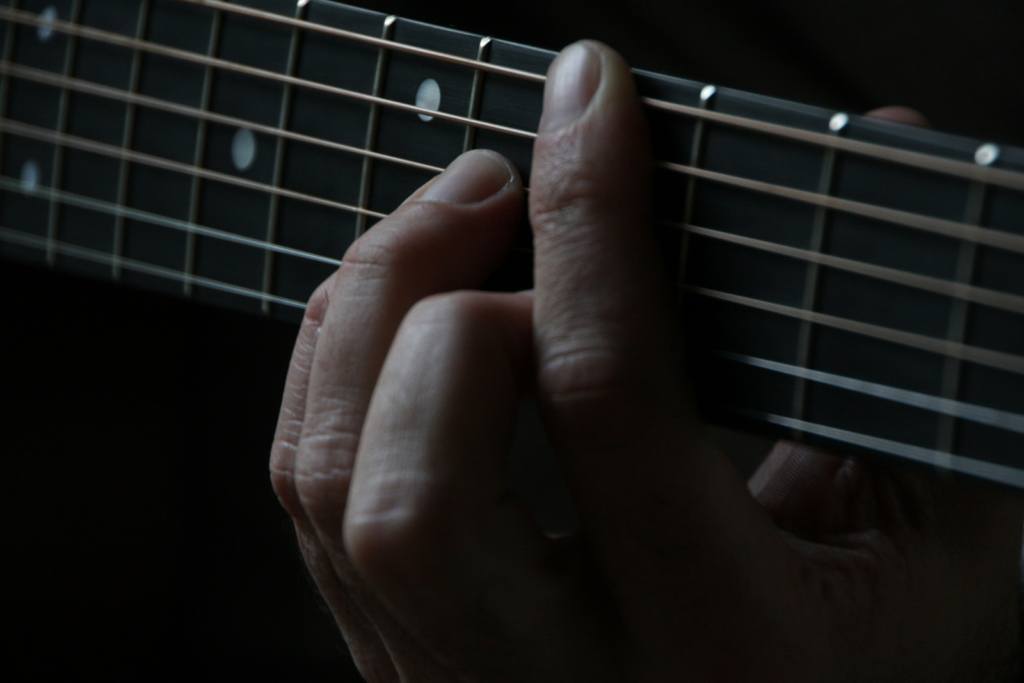
Krank Revolution1: Dimebag’s Venture into the Tube Realm
As the metal world evolved, so did Dimebag Darrell’s quest for the ultimate tone. Around 2003-2004, Dimebag’s exploration led him to Krank Amplifiers, marking a significant shift in his setup from his solid-state roots to the rich harmonics of tube amplification.
With a keen ear for raw power and distinctive sound, Dimebag reached out to Krank, intrigued by their flagship model. Upon his request, Krank sent over the Revolution1, an amplifier that would soon become a key element in his rig.
Onstage, Dimebag wielded a trio of Krank Revolution heads, each feeding into dual cabinets loaded with Eminence Texas Heat speakers. This configuration was designed to produce a wall of sound that could carry the aggressive overtones of Damageplan’s music while maintaining the clarity of each bone-rattling note.
The Krank Revolution1: A Tube Amp with a Difference
Transitioning to the Krank Revolution1 was a pivotal moment for Dimebag. Not only was this his first foray into using a tube amplifier extensively, but it was also a departure from the trademark sound that had defined his earlier years. The Revolution1 was a 100-watt powerhouse that defied the expectations of what a tube amp could do in the realm of heavy metal. Its robust gain structure allowed Dimebag to achieve the high levels of saturation he desired without sacrificing the warm, full-bodied character that tube amps are celebrated for.
Dimebag’s affinity for the Revolution1’s gain prowess highlighted his innovative spirit and adaptability as a musician. While many tube amplifiers of the time were associated with a classic rock vibe, the Krank Revolution1 had a modern edge that was more aligned with Dimebag’s aggressive playing style. This amp was not just a change in technology; it was a statement that Dimebag was ever-evolving, relentlessly pushing the boundaries of metal.
The Legacy of Dimebag and the Krank Revolution1
In the hands of Dimebag Darrell, the Krank Revolution1 became more than an amplifier; it was a testament to his enduring impact on guitar tone and the metal genre. He integrated the Revolution1 into his live setup with Damageplan, showcasing how tube amplification could be harnessed to deliver devastatingly heavy music.
Dimebag’s endorsement of the Krank Revolution1 speaks volumes about the amp’s capabilities. It was capable of delivering the guttural punch and razor-sharp precision that Dime’s music required while also offering the depth and resonance that only tubes can provide.
The Krank Revolution1 will forever be associated with the latter part of Dimebag’s career, symbolizing a period of artistic growth and sonic exploration.
Dimebag’s shift to the Krank Revolution1 in the final chapter of his career showed the world that his musical journey was far from static. It continued to evolve, much like the heavy metal landscape he helped to shape. The Krank Revolution1 was not just another amplifier in his collection; it was a bold step into a new sonic frontier—a step taken by a guitarist who never stopped seeking the perfect sound.
Krank Krankenstein: Dimebag’s Signature Roar
In the perpetual search for a sound that could encapsulate his searing riffs and unparalleled aggression, Dimebag Darrell partnered with Krank Amplifiers to forge a new beast—the Krankenstein. This collaboration was a natural progression from the Revolution1, as Dimebag sought to refine and perfect an amplifier that was truly his own.
Built upon the formidable foundation of the Revolution1’s circuitry, the Krankenstein was a statement of intent, a testament to Dimebag’s hands-on approach to his sound. This all-tube amplifier retained the bone-crushing gain that Dimebag so heavily relied upon, but it also presented a tweak in its clean channel, which was reworked to deliver a warmer and more harmonically rich clean tone.
The Approval and Legacy of the Krankenstein
In a poignant twist of fate, Dimebag Darrell approved the final design of the Krankenstein just days before his tragic passing. Despite the devastating loss to the guitar world, his sonic signature would not go unheard. The Krankenstein was put into production posthumously, serving as a roaring tribute to Dimebag’s relentless pursuit of the ultimate heavy metal sound.
The introduction of the Krankenstein to the market allowed fans and fellow guitarists to experience a piece of Dimebag’s vision. Its arrival was met with a mix of enthusiasm and reverence as players across the globe sought to tap into the ferocious tones that Dimebag had helped to craft.
In essence, the Krankenstein stands as a robust continuation of Dimebag Darrell’s indelible impact on the music industry. For those who seek to channel his energy and intensity, the Krankenstein is a fitting monument to a man whose life was dedicated to pushing the boundaries of metal, both in technical prowess and in the gear that defines the genre.
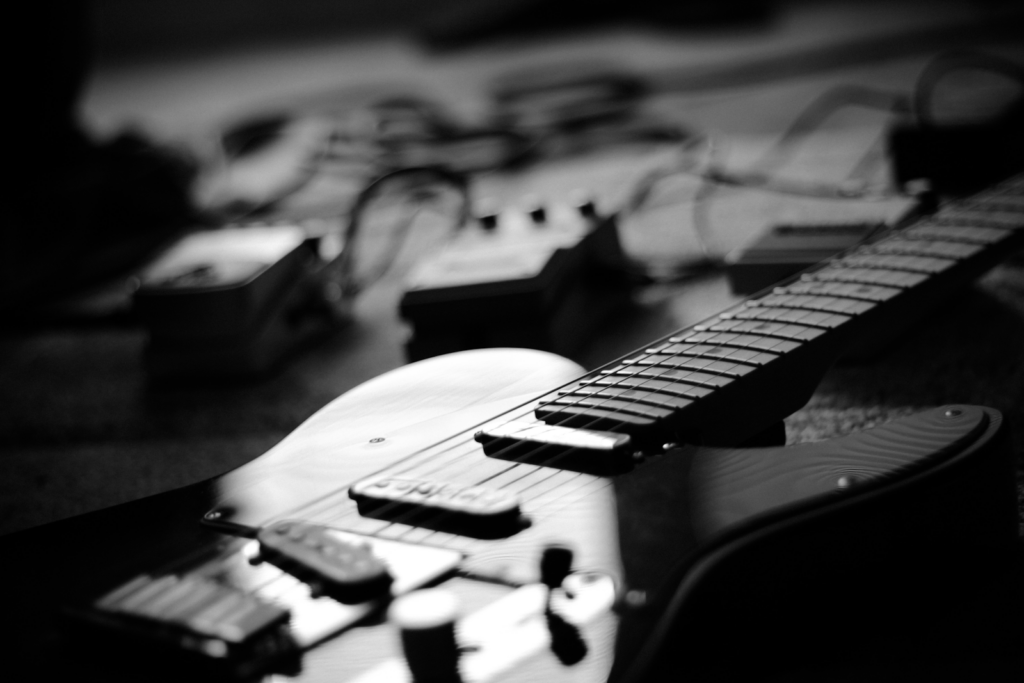
Frequently Asked Questions
Who taught Dimebag Darrell how to play guitar?
Dimebag Darrell was primarily self-taught when it came to playing the guitar. However, he was born into a musical family, and his father, Jerry Abbott, was a country music songwriter and producer who undoubtedly had an influence on Dimebag’s musical education.
From a young age, Dimebag showed an extraordinary talent for the guitar, refining his skills through hours of practice and absorbing the techniques of his guitar heroes.
Who made Dimebag’s guitars?
Dimebag’s guitars were made by several manufacturers over the course of his career.
Initially, he was famous for using Dean guitars, specifically the Dean ML model, which became his trademark in the early days of Pantera. Later, he had a relationship with Washburn Guitars, who produced the Dime 3 series.
Towards the end of his career, he reconnected with Dean guitars to develop the Dean Razorback, a model that was released posthumously.
Why was he called Dimebag Darrell?
Darrell was originally known as “Diamond Darrell” when Pantera was more of a glam metal band. The nickname “Dimebag” emerged in the early ’90s.
There are a couple of stories about how he got this nickname; one is that it was because of his penchant for carrying around bags of weed, often referred to as “dime bags.” Another story suggests it was a term of endearment and a play on his original nickname, given the drastic change in his music style from glam to a heavier sound.
Regardless of the origin, the name “Dimebag Darrell” stuck and became a moniker that fans and the music community embraced wholeheartedly.
Conclusion: The Enduring Legacy of Dimebag Darrell’s Sound
Dimebag Darrell’s legacy is etched into the annals of metal not only through his fearless playing and compositional skills but also through the distinctive equipment that helped forge his sound. The journey through Dimebag’s guitars and amplifiers is more than a retrospective of gear; it’s a voyage into the heart of a musician’s relentless pursuit of the ultimate tone.
From the fiery licks on the ‘Dean from Hell’ to the uncompromising crunch of the Krankenstein amp, each piece of equipment carries a story, a chapter of Dimebag Darrell’s ongoing influence. His signature guitars, crafted with precision by Dean and Washburn, continue to inspire guitarists who wish to walk in the footsteps of his ferocious style. The guitar was Dimebag’s brush, and the metal landscape was his canvas.
The amplifiers, from the solid-state Randall models that shaped the raw sound of Pantera to the tube-driven warmth of the Krank series, illustrate Dimebag’s evolution as an artist. They are a reminder that while his time was tragically cut short, his sonic exploration was boundless. The Krankenstein, in particular, serves as a posthumous release of his creative spirit—a spirit that remains unchained and alive in every chug, every squeal, and every riff that resonates from his endorsed equipment.
Dimebag Darrell, amplifiers, guitars, and his indomitable spirit live on in the hands of musicians around the globe. His influence on the guitar world is undeniable, and his dedication to his craft ensures that he will be remembered not just as a guitarist but as an innovator who redefined what heavy metal could be.
So, as we look back on the tools of Dimebag’s trade, we’re reminded that these are not mere inanimate objects. They are conduits of creativity, instruments of expression, and, for many, sacred relics that continue to carry the torch of Dimebag Darrell’s extraordinary contribution to music. His tone, his technique, and his tenacity are immortalized in every strum, every dive bomb, and every harmonic that screams from the strings of Dime’s guitars.
Dimebag’s story is a poignant reminder that the soul of music lies not just in the notes played but in the passion woven into them—a passion that still inspires, that still feeds the fire of metal, and that continues to push guitarists to play barre chords with more heart, to tweak their neck pickups in search of that perfect sound, and to step on their Digitech Whammy pedals with the spirit of a true innovator. Dimebag Darrell may have left the stage, but the echo of his music will live on forever.


